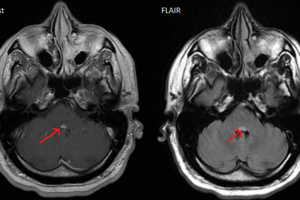It should first be emphasized that the terms vestibular neuronitis (VN) and acute viral labyrinthitis or epidemic labyrinthitis are not interchangeable. VN is an entity that does not involve the labyrinths at all. There are viral and bacterial infections of the labyrinthine system, but they are rare. They also involve a hearing loss. VN is a lesion of the vestibular nerve and/or the vestibular nuclei and its second order neurons.
The hallmarks of VN are a sudden onset, the absence of any cochlear involvement, i.e. tinnitus and hearing loss, and an absence of other neurologic symptoms. A non-essential characteristic is the absence of a caloric response.
The clinical syndrome consists of vertigo, sometimes severe enough to cause vomiting, and the vomiting can sometimes be severe enough to require hospitalization. Head movement will typically trigger an attack of the vertigo although there are some cases where it is relatively constant. Often, the symptoms begin while a patient is asleep and will appear upon awakening.
The only physical finding is nystagmus. It is fine horizontal or rotary. It is always directed away from the side of the lesion.
The disease is benign. Its most severe stage lasts 2 to 3 days and it will resolve within weeks. The average length of time prior to resolution is 3 weeks but some cases have lasted as long as 9.
Because VN occurs in an epidemic pattern, there as long been a theory that infection plays a role in its pathophysiology. However, no organism has ever been recovered from tyhe blood or tissue samples taken from people suffering from VN. The agents implicated include adenovirus, herpes simplex, cytomegalovirus, parainfluenza and even neuroborelliosis.
While corticosteroids are effective for the treatment of acute vestibular neuritis, antiviral agents are not. Initially, some symptomatic relief can be achieved from the use of antiemetics and vestibular suppressants such as meclizine, diazepam, or promethazine. However, long term use of these medications has a side effect of inhibiting full recovery. Such use apparently prevents CNS adaptation. Also, sine the4 medications are sedating, they increase the likelihood of falls. During the acute phase, combining these medications with caffeine will minimize drowsiness.
The differential diagnosis for VN is basically the same as that for vertigo, but its clear cut clinical characteristics and tendency to occur in mini-epidemics make it an easy diagnosis to establish.


